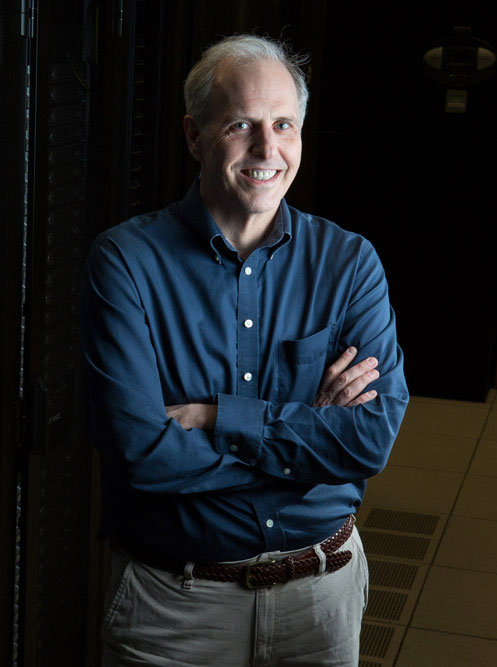
When Jonathan Haines was learning about genetics in his high school biology class, he thought it was going to be pretty straightforward—you get one copy of genes from mom, one copy from dad and that’s it.
“By the time I realized it was really complex, I was already hooked,” said Haines, the Mary W. Sheldon MD Professor of Genomic Sciences and the chair of the Department of Population and Quantitative Health Sciences at Case Western Reserve University.
In recognition of today (Sept. 21) being World Alzheimer’s Day—a time to raise awareness about the disease and its designation as the most common form of dementia—The Daily sat down with Haines, an internationally recognized researcher and educator, to learn more about Alzheimer’s, which has been a major focus of his for decades.
“There’s a general misconception that having memory problems and having Alzheimer’s disease is a natural aging process, and it’s not,” Haines explained. “There are quite a few people who are in their 90s who are just as sharp as they were when they were in their 20s.”
Nowadays, Haines studies populations that historically have not been represented in large-scale genetic research at the Cleveland Alzheimer’s Disease Research Center, where he’s the leader of the Data Management and Statistics Core. The center supports the advancement of research for Alzheimer’s disease and related dementias.
Read on to learn more from Haines about Alzheimer’s disease.
1. The biggest risk factor for Alzheimer’s is genetics—but it’s not the only one.
Family history is a significant risk factor, so if you have parents and grandparents who have developed dementia, you are at higher risk, there’s no question about that. Just because your genetic risk is high doesn’t mean you’re absolutely going to get it, (but) it increases the risk. There’s also an association with education; the more education somebody has, the lower the risk. Whether that’s causative in any way, or if that’s just associated for some other reason, we don’t know, but that’s a very strong risk factor.
Other non-genetic risk factors in developing dementia are cardiovascular disease, diabetes and obesity. Additionally, the frequency is, as far as we can tell, higher in the African American and in the Hispanic communities. There are all sorts of subtleties to this, but some of that increased risk might be because of the increase of cardiovascular disease in African Americans.
2. Alzheimer’s is one of the leading causes of death in the U.S.
People tend to think Alzheimer’s disease doesn’t cause death, but in fact, as the disease progresses, people can’t take care of themselves, they tend to get sick, they might not be able to feed themselves and things like that—so it’s a leading cause of death. It’s one of the few leading causes of death that’s going up in frequency, not down in frequency.
3. There’s no treatment for Alzheimer’s disease.
Despite 30 years of intense study, we have not been able to develop any sort of treatment that really affects the actual process of developing dementia. There are a few drugs out there that modify some of the symptoms for some period of time, but there is no drug out there—no intervention, even if it’s not a drug—that we know can either lower the risk significantly or prevent the development of Alzheimer’s disease.
We’ve made a huge amount of progress on the genetics side. I was one of the discoverers of ApoE, which is the biggest genetic risk factor (the variations in the ApoE gene). We’ve made a huge amount of progress, and despite the fact that it hasn’t led to a drug or a treatment, it has helped us to much better understand what the processes are and what tissues and cells within the brain are actually the ones that we need to study.
4. The biological process of Alzheimer’s probably starts 20 to 30 years before clinical symptoms.
Something disconcerting that the field has begun to realize over the last 10 or 15 years is that the biological process of Alzheimer’s disease probably starts 20 to 30 years before you have clinical symptoms. That process may be starting in somebody’s 40s, and they’re going to be perfectly fine for 20 years, but that process has started and that’s disconcerting because it’s hard to study a process that’s going to take 30 years to get to the clinical symptoms.
5. Alzheimer’s disease is a healthcare crisis.
There are over 6 million individuals in the U.S. with Alzheimer’s dementia. That’s expected to double over the next 30 years as the population ages. It’s really common, it’s obviously an age-related disease so it’s common after the age of 65.
Over the past 10 years, there’s been a huge increase in the federal support for studying Alzheimer’s disease; it’s partly why the Cleveland Alzheimer’s Disease Research Center is here, it’s partly why we have gotten substantial funding for our research. That’s because there’s a congressional mandate to develop a successful treatment for Alzheimer’s. Congress has put a lot of money into this through the National Alzheimer’s Project Act.

